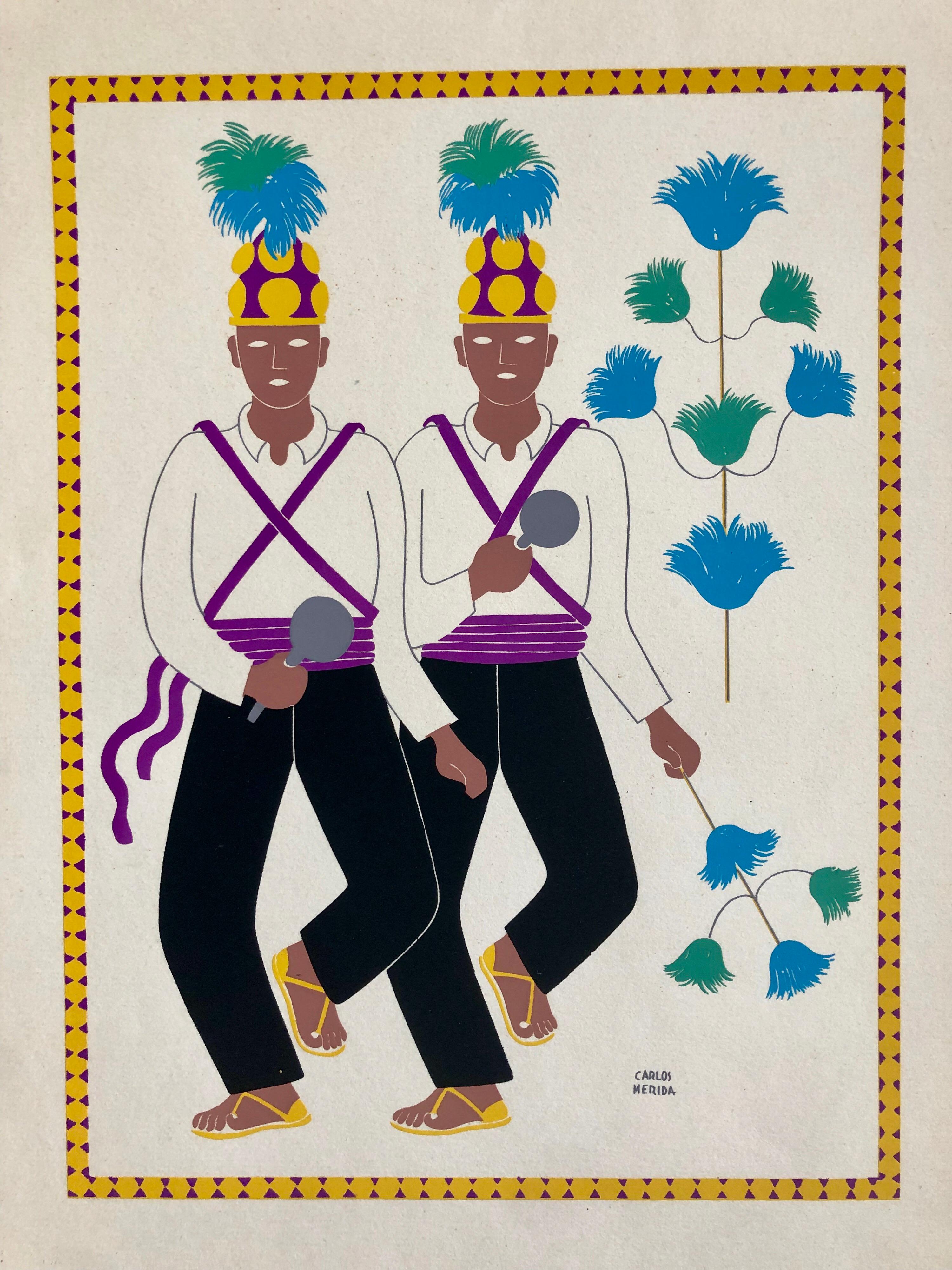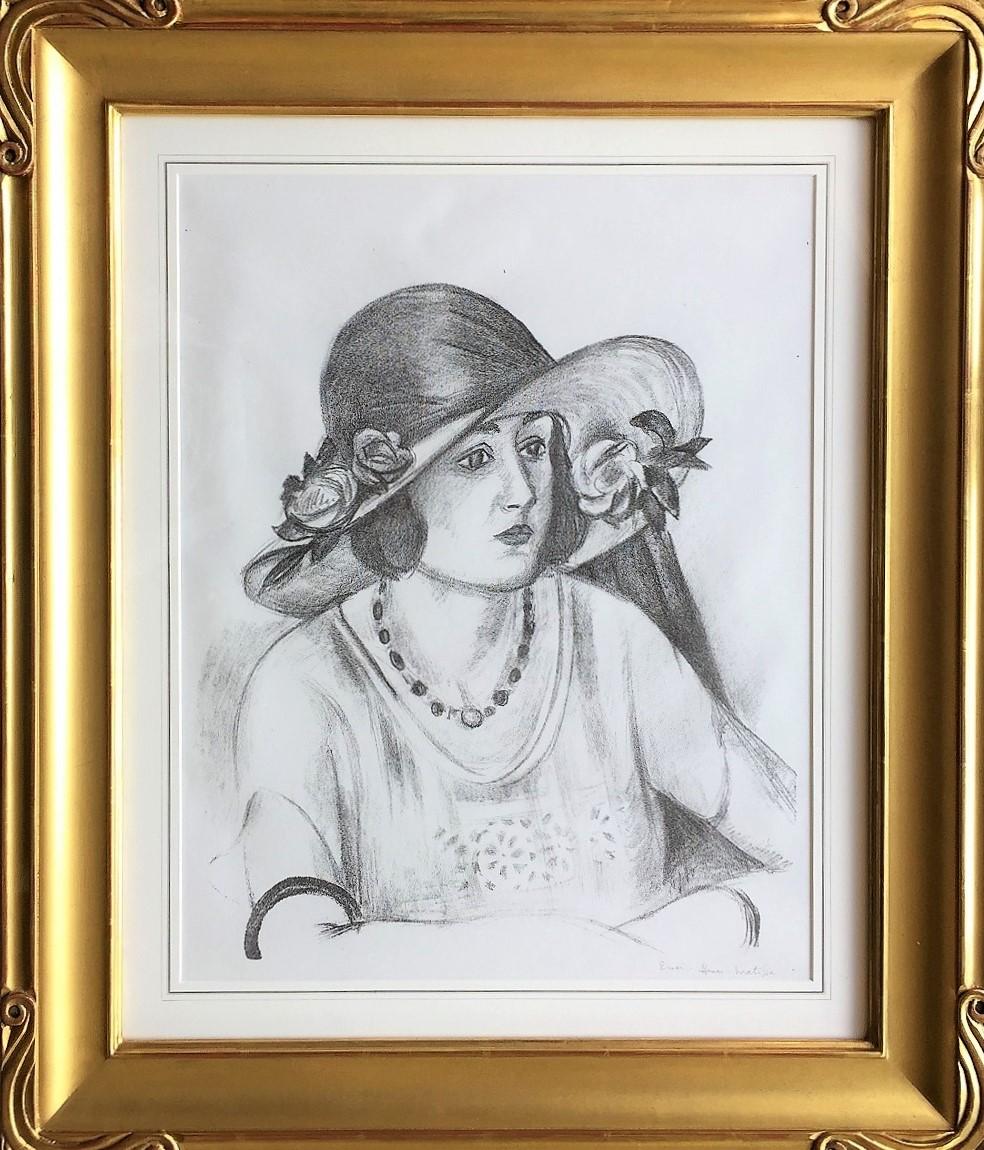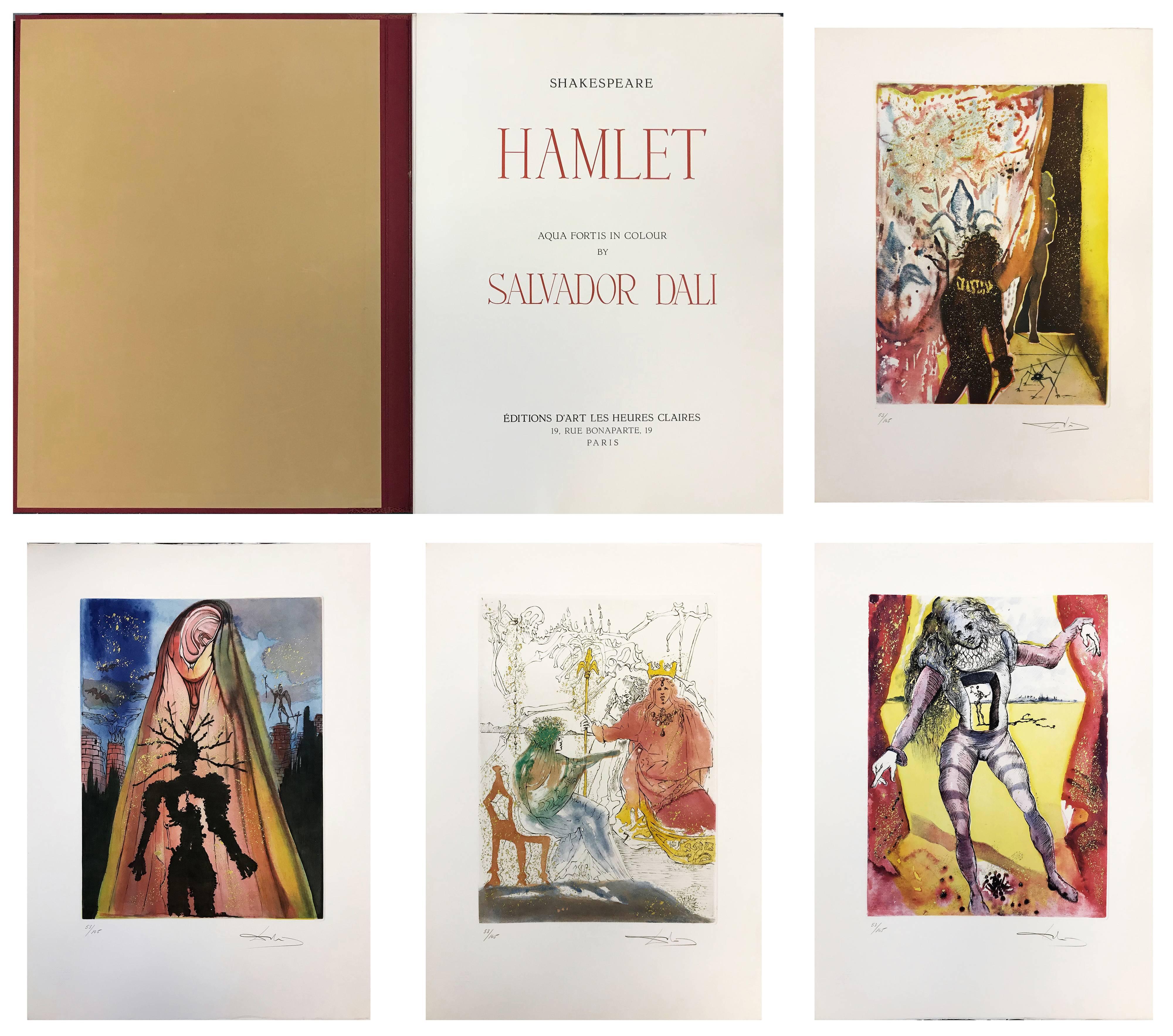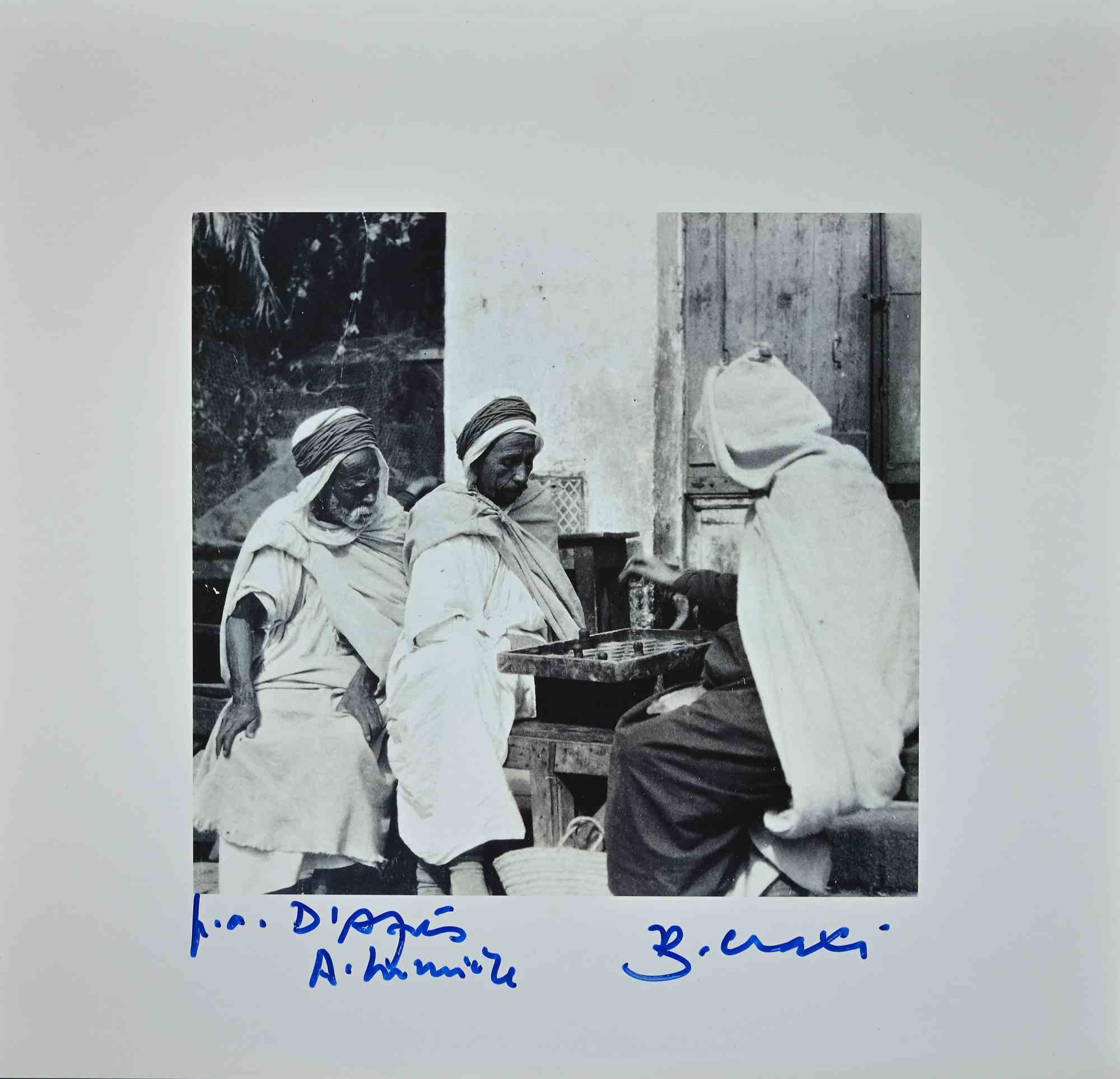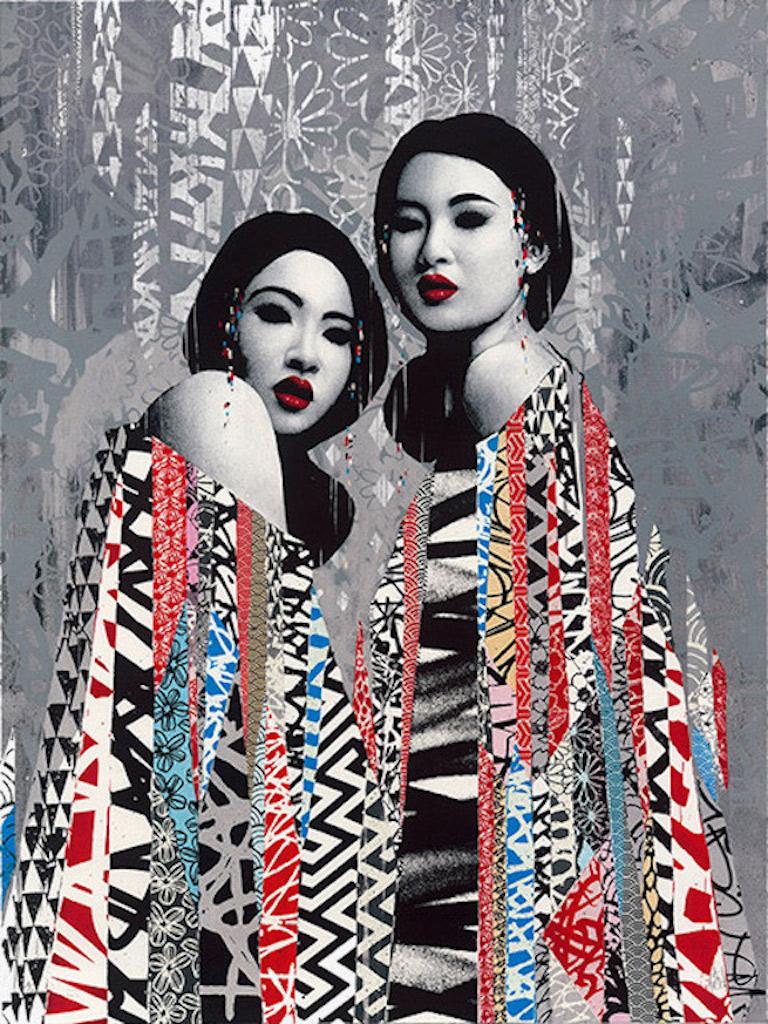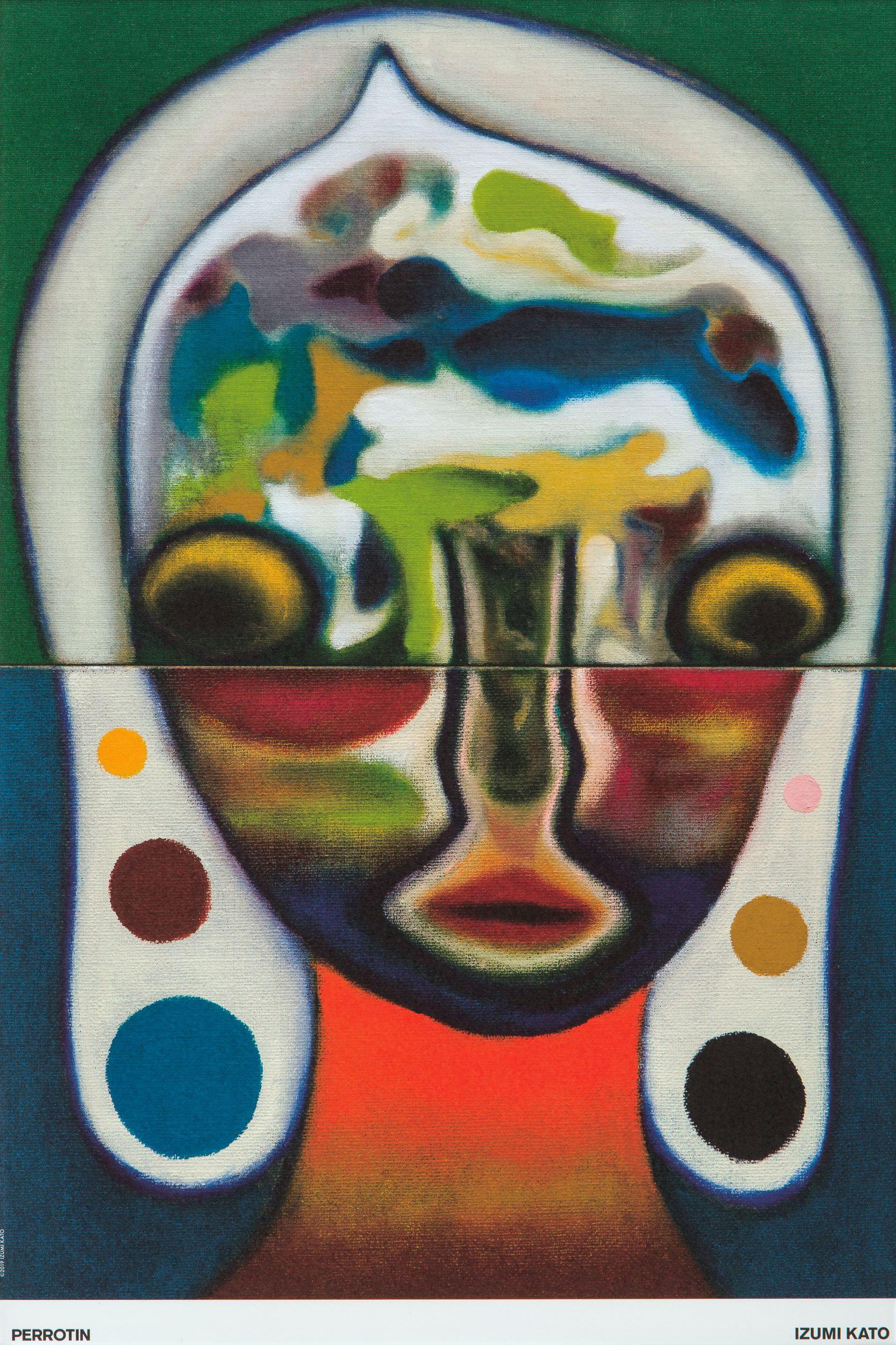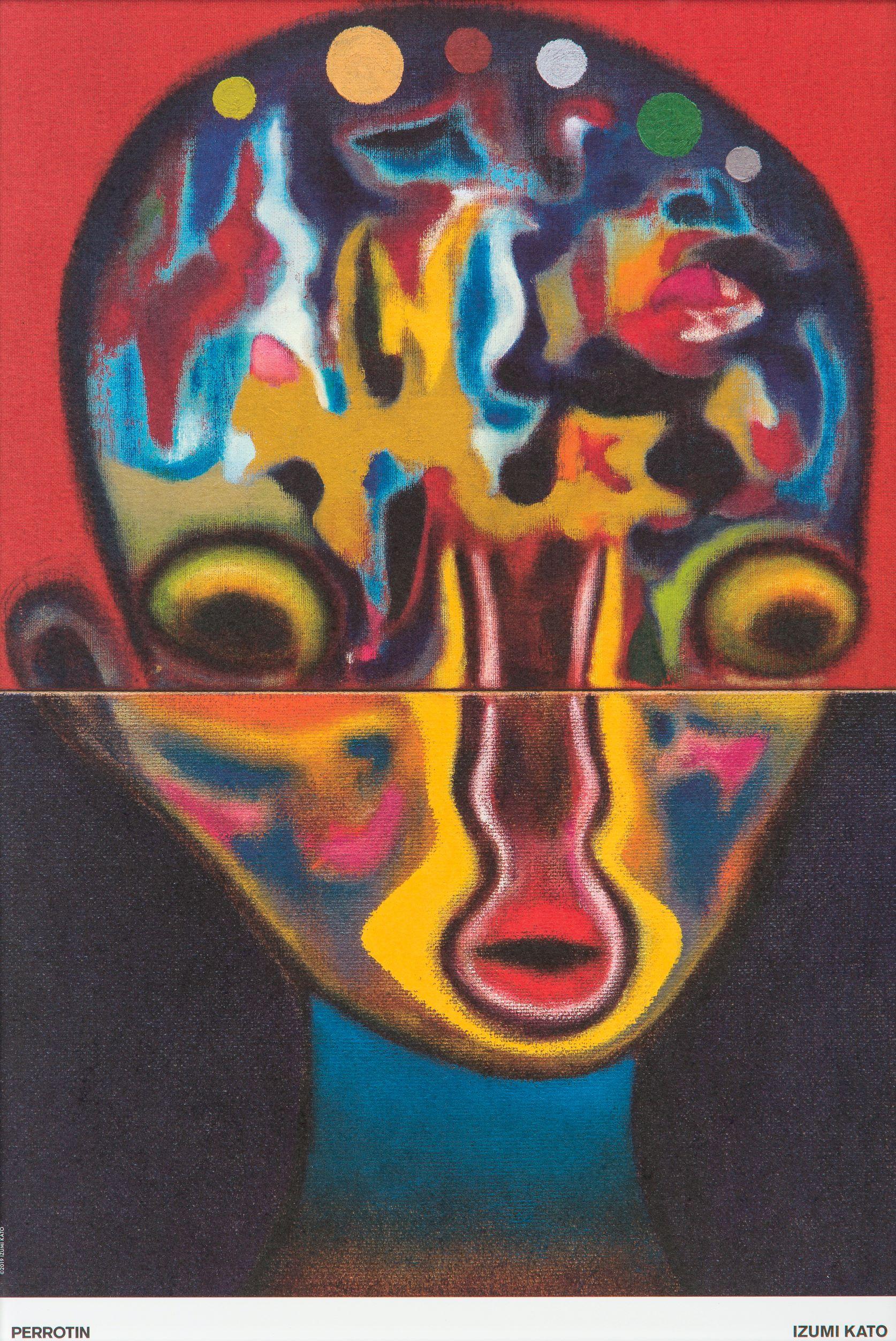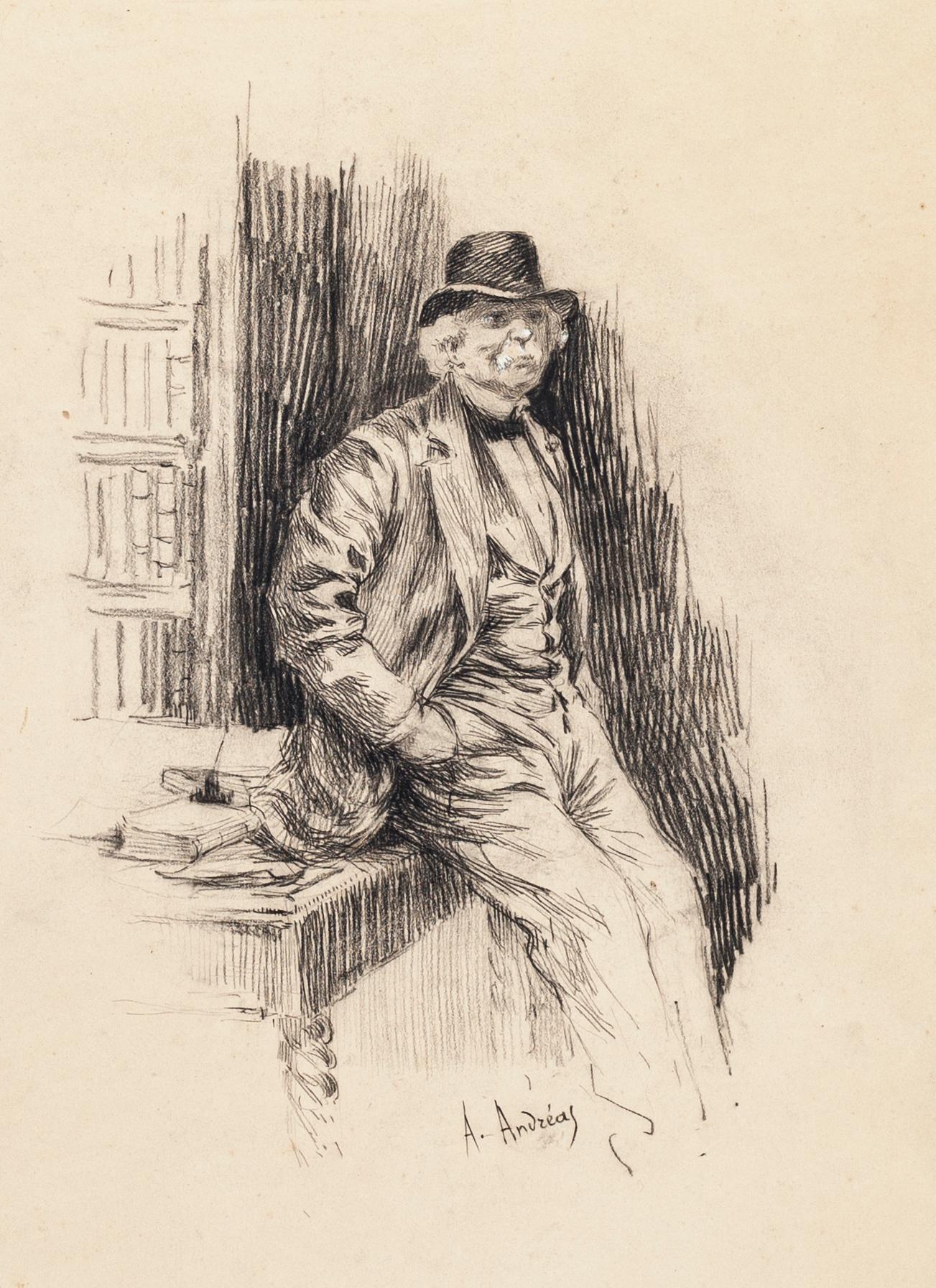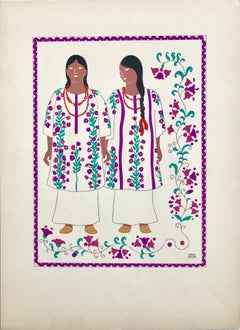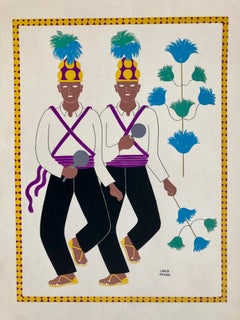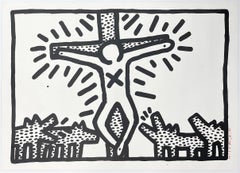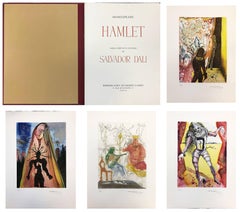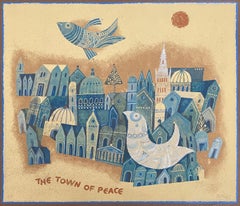
Israeli Modernist Judaica Lithograph - The Town Of Peace
View Similar Items
Want more images or videos?
Request additional images or videos from the seller
1 of 12
Sami BrissIsraeli Modernist Judaica Lithograph - The Town Of Peace
About the Item
- Creator:Sami Briss (1930, French)
- Dimensions:Height: 19.5 in (49.53 cm)Width: 21 in (53.34 cm)
- Medium:
- Movement & Style:
- Period:
- Condition:Good, please see photos.
- Gallery Location:Surfside, FL
- Reference Number:1stDibs: LU3826657512
About the Seller
4.9
Platinum Seller
These expertly vetted sellers are 1stDibs' most experienced sellers and are rated highest by our customers.
Established in 1995
1stDibs seller since 2014
1,553 sales on 1stDibs
Typical response time: 1 hour
More From This SellerView All
- 1945 Mexican Modernist Silkscreen Serigraph Print Regional Folk Art Dress MexicoLocated in Surfside, FLThis listing is for the one Silkscreen serigraph piece listed here. Mexico City, 1945. First edition. plate signed, limited edition of 1000, these serigraph plates depict various types of traditional and folk art indigenous clothing and costume styles from around Mexico. The illustrations depict the cultures of many different states in Mexico, including Oaxaca, Chiapas, Jalisco and Veracruz. Carlos Mérida (December 2, 1891 – December 21, 1985) was a Guatemalan artist who was one of the first to fuse European modern painting to Latin American themes, especially those related to Guatemala and Mexico. He was part of the Mexican muralism movement in subject matter but less so in style, favoring a non-figurative and later geometric style rather than a figurative, narrative style. Mérida is best known for canvas and mural work, the latter including elements such as glass and ceramic mosaic on major constructions in the 1950s and 1960s. One of his major works, on the Benito Juarez housing complex, was completely destroyed with the 1985 Mexico City earthquake, but a monument to it exists at another complex in the south of the city. Carlos Mérida was born Carlos Santiago Ortega in Guatemala City to Serapio Santiago Mérida and Guadalupe Ortega Barnoya. He later changed his name what is known by as he thought it was more sonorous. His brothers and children also took the Mérida name later on. He was of mixed Spanish/Maya-Quiché heritage which he promoted during his life. As a young child, Mérida had both music and art lessons, and his first passion was music, which led to piano lessons. He studied at a trade school called the Instituto de Artes y Oficios, then the Instituto de Ciencias y Letras. Here he began to have a reputation for the avant garde. Merída’s first trip to the United States was in 1917, where he met writer Juan José Tablada. Mérida made several trips to Europe over his lifetime to both study art and work as an artist and diplomat. His early trips in the 1920s and 1930s put him in touch with both avant garde movements in Europe as well as noted Latin American artists, especially those from Mexico. His last trip was in 1950s. In 1963, he donated canvases, graphic pieces and mural sketches to the Universidad Nacional Autónoma de Mexico. Merida was one of a number of artists such as Diego Rivera and Gerardo Murillo who became committed to promoting the handcrafts and folk art of Mexico and Central America, with a particular interest in those of Guatemala, often featuring Mayan textiles or elements in their decoration in his artwork. He died in Mexico City at the age of 94 on December 21, 1985. As there was little opportunity for artists in Guatemala, in 1910, Mérida traveled to Paris with a friend named Carlos Valenti on a German cargo ship. From then until 1914, he lived and worked in Paris and traveled much of Europe. This put him in touch with European avant garde artists such as Van Dagen, Amedeo Modigliani, Pablo Picasso and Piet Mondrian as well as Latin American artists studying in Europe such as Diego Rivera, Jorge Enciso, Ángel Zárraga and Dr. Atl. He exhibited his work in venues such as the Independent Salon and the Giroux Gallery in Paris. Mérida has forty five exhibitions in the United States and eighteen in Mexico from 1928 to 1948. These included an exhibition with Rufino Tamayo at the Art Center of New York (1930), the John Becker and Valentine galleries in New York (1930), the Club de Escritores de México and the Galería Posada in Mexico City (1931), the Stendhal Gallery and the Stanley Rose...Category
1940s Folk Art Portrait Prints
MaterialsScreen
- 1945 Mexican Modernist Silkscreen Serigraph Print Regional Folk Art Dress MexicoLocated in Surfside, FLThis listing is for the one Silkscreen serigraph piece listed here. Mexico City, 1945. First edition. plate signed, limited edition of 1000, these serigraph plates depict various types of traditional and folk art indigenous clothing and costume styles from around Mexico. The illustrations depict the cultures of many different states in Mexico, including Oaxaca, Chiapas, Jalisco and Veracruz. Carlos Mérida (December 2, 1891 – December 21, 1985) was a Guatemalan artist who was one of the first to fuse European modern painting to Latin American themes, especially those related to Guatemala and Mexico. He was part of the Mexican muralism movement in subject matter but less so in style, favoring a non-figurative and later geometric style rather than a figurative, narrative style. Mérida is best known for canvas and mural work, the latter including elements such as glass and ceramic mosaic on major constructions in the 1950s and 1960s. One of his major works, on the Benito Juarez housing complex, was completely destroyed with the 1985 Mexico City earthquake, but a monument to it exists at another complex in the south of the city. Carlos Mérida was born Carlos Santiago Ortega in Guatemala City to Serapio Santiago Mérida and Guadalupe Ortega Barnoya. He later changed his name what is known by as he thought it was more sonorous. His brothers and children also took the Mérida name later on. He was of mixed Spanish/Maya-Quiché heritage which he promoted during his life. As a young child, Mérida had both music and art lessons, and his first passion was music, which led to piano lessons. He studied at a trade school called the Instituto de Artes y Oficios, then the Instituto de Ciencias y Letras. Here he began to have a reputation for the avant garde. Merída’s first trip to the United States was in 1917, where he met writer Juan José Tablada. Mérida made several trips to Europe over his lifetime to both study art and work as an artist and diplomat. His early trips in the 1920s and 1930s put him in touch with both avant garde movements in Europe as well as noted Latin American artists, especially those from Mexico. His last trip was in 1950s. In 1963, he donated canvases, graphic pieces and mural sketches to the Universidad Nacional Autónoma de Mexico. Merida was one of a number of artists such as Diego Rivera and Gerardo Murillo who became committed to promoting the handcrafts and folk art of Mexico and Central America, with a particular interest in those of Guatemala, often featuring Mayan textiles or elements in their decoration in his artwork. He died in Mexico City at the age of 94 on December 21, 1985. As there was little opportunity for artists in Guatemala, in 1910, Mérida traveled to Paris with a friend named Carlos Valenti on a German cargo ship. From then until 1914, he lived and worked in Paris and traveled much of Europe. This put him in touch with European avant garde artists such as Van Dagen, Amedeo Modigliani, Pablo Picasso and Piet Mondrian as well as Latin American artists studying in Europe such as Diego Rivera, Jorge Enciso, Ángel Zárraga and Dr. Atl. He exhibited his work in venues such as the Independent Salon and the Giroux Gallery in Paris. Mérida has forty five exhibitions in the United States and eighteen in Mexico from 1928 to 1948. These included an exhibition with Rufino Tamayo at the Art Center of New York (1930), the John Becker and Valentine galleries in New York (1930), the Club de Escritores de México and the Galería Posada in Mexico City (1931), the Stendhal Gallery and the Stanley Rose...Category
1940s Folk Art Figurative Prints
MaterialsScreen
- 1945 Mexican Modernist Silkscreen Serigraph Print Regional Folk Art Dress MexicoLocated in Surfside, FLThis listing is for the one Silkscreen serigraph piece listed here. Mexico City, 1945. First edition. plate signed, limited edition of 1000, these serigraph plates depict various types of traditional and folk art indigenous clothing and costume styles from around Mexico. The illustrations depict the cultures of many different states in Mexico, including Oaxaca, Chiapas, Jalisco and Veracruz. Carlos Mérida (December 2, 1891 – December 21, 1985) was a Guatemalan artist who was one of the first to fuse European modern painting to Latin American themes, especially those related to Guatemala and Mexico. He was part of the Mexican muralism movement in subject matter but less so in style, favoring a non-figurative and later geometric style rather than a figurative, narrative style. Mérida is best known for canvas and mural work, the latter including elements such as glass and ceramic mosaic on major constructions in the 1950s and 1960s. One of his major works, on the Benito Juarez housing complex, was completely destroyed with the 1985 Mexico City earthquake, but a monument to it exists at another complex in the south of the city. Carlos Mérida was born Carlos Santiago Ortega in Guatemala City to Serapio Santiago Mérida and Guadalupe Ortega Barnoya. He later changed his name what is known by as he thought it was more sonorous. His brothers and children also took the Mérida name later on. He was of mixed Spanish/Maya-Quiché heritage which he promoted during his life. As a young child, Mérida had both music and art lessons, and his first passion was music, which led to piano lessons. He studied at a trade school called the Instituto de Artes y Oficios, then the Instituto de Ciencias y Letras. Here he began to have a reputation for the avant garde. Merída’s first trip to the United States was in 1917, where he met writer Juan José Tablada. Mérida made several trips to Europe over his lifetime to both study art and work as an artist and diplomat. His early trips in the 1920s and 1930s put him in touch with both avant garde movements in Europe as well as noted Latin American artists, especially those from Mexico. His last trip was in 1950s. In 1963, he donated canvases, graphic pieces and mural sketches to the Universidad Nacional Autónoma de Mexico. Merida was one of a number of artists such as Diego Rivera and Gerardo Murillo who became committed to promoting the handcrafts and folk art of Mexico and Central America, with a particular interest in those of Guatemala, often featuring Mayan textiles or elements in their decoration in his artwork. He died in Mexico City at the age of 94 on December 21, 1985. As there was little opportunity for artists in Guatemala, in 1910, Mérida traveled to Paris with a friend named Carlos Valenti on a German cargo ship. From then until 1914, he lived and worked in Paris and traveled much of Europe. This put him in touch with European avant garde artists such as Van Dagen, Amedeo Modigliani, Pablo Picasso and Piet Mondrian as well as Latin American artists studying in Europe such as Diego Rivera, Jorge Enciso, Ángel Zárraga and Dr. Atl. He exhibited his work in venues such as the Independent Salon and the Giroux Gallery in Paris. Mérida has forty five exhibitions in the United States and eighteen in Mexico from 1928 to 1948. These included an exhibition with Rufino Tamayo at the Art Center of New York (1930), the John Becker and Valentine galleries in New York (1930), the Club de Escritores de México and the Galería Posada in Mexico City (1931), the Stendhal Gallery and the Stanley Rose...Category
1940s Folk Art Figurative Prints
MaterialsScreen
- French Armenian Jean Jansem Lithograph Mod Woman in Orange Hand Signed ModernistBy Jean JansemLocated in Surfside, FLHand signed in pencil and numbered from the limited original edition. Jean Jansem (Hovhannes Semerdjian) 1920-2013 Bursa, Ottoman Turkish Empire Hovhannes "Jean" Semerdjian (Armenian: Հովհաննես "Ժանսեմ" Միրիջանի Սեմերջյան, 9 March 1920 – 27 August 2013), also known as Jean Jansem, was a French-Armenian painter. Jansem's artworks are internationally known, and are part of museum collections throughout France, Japan and the United States. A Foreign member of the National Academy of Sciences of Armenia (2002). He was awarded by the Ordre des Arts et des Lettres in 1953 and by the Knight of the French Legion of Honour in 2003. The President of Armenia awarded Jansem a Medal of Honor for his “reinforcement of Armenian-French cultural ties.” Hovhannes Semerdjian was born in 1920 in Bursa, then in the Ottoman Empire. In 1922, his family fled to Greece. He spent his childhood in Thessaloniki. They arrived to Issy-les-Moulineaux suburb of Paris, France in 1931 when he was 11 and that is when he begin to paint. The first professional schools for Jansem became the academies of Montparnasse (1934–1936). He studied in the Ecole des Arts Decoratifs. His teachers were Maurice Brianchon, Raymond Legueult and Roland Oudot. Jansem also studied at the Sabatie studio for a year. Early paintings by Jansem were mainly on national issues. Known for his washy representational paintings of figure, landscape, marine and genre scenes of European subjects: fishermen and children of Greece, bullfighting in Spain, Italian landscapes and markets, scenes of Venice and French France village marketplaces and landscapes, nude women, still lifes, and figures, Jansem painted with a variety of media that included gouache, watercolor, ink, and oil painting in a stylized and textural aesthetic. had individual exhibitions in Paris, New York, Chicago, London, Tokyo, Rome, Brussels, Lausanne, Beirut etc. His work was shown by the prominent Wally Findlay Galleries in New York, Paris, Palm Beach and Beverly Hills (they show many important artists including Gaston Sebire, Henri Maik, Gen Paul, Jean Pierre Cassigneul, Jean Dufy, Gustavo Novoa, Nicola Simbari, Dietz Edzard, Suzanne Eisendieck, Constantin Kluge, Louis Valtat, Michael Vollbracht...Category
1960s Modern Figurative Prints
MaterialsLithograph
- Lithograph Israeli Modernist Judaica, Kibbutz Boy, Bezalel ArtistBy Moshe GatLocated in Surfside, FLA signed and numbered lithograph print. Moshe Gat was born in Haifa in 1935. in 1952 he began his studies at the Bezalel School, in Jerusalem. In 1955 he returned to Haifa, where h...Category
Mid-20th Century Expressionist Figurative Prints
MaterialsLithograph
- Lithograph Print Pattern & Decoration Art Honor Father & Mother Robert KushnerBy Robert KushnerLocated in Surfside, FLRobert Ellis Kushner (American, b.1949). 44/84 Lithograph on paper titled " Honor thy Mother and Father"; Depicting a husband and wife (I have seen this print described as a screenprint and as a lithograph) Hand signed in pencil and dated alongside an embossed pictorial blindstamp of a closed hand with one raised index finger. Solo Press. From The Ten Commandments Kenny Scharf; Joseph Nechvatal; Gretchen Bender; April Gornik; Robert Kushner; Nancy Spero; Vito Acconci; Jane Dickson; Judy Rifka; Richard Bosman and Lisa Liebmann. Robert Kushner, born in 1949, in California, lives in New York, and is a painter and sculptor. He gained attention in the early seventies as a performance artist, using food, fabric and nudity. Kushner was associated with the Pattern and Decoration movement and used fabric collage in large-scale, bold paintings of the figure. Since 1987 he has used flowers as the subject of his paintings, more recently adding a cornucopia of fruits and vegetables to his repertoire. Kushner's use of rich color harmonies and bold, fluid drawing, mark his belief in the importance of beauty in our lives. Kushner draws from a unique range of influences, including Islamic and European textiles, Henri Matisse, Georgia O'Keeffe, Charles Demuth, Pierre Bonnard, Tawaraya Sotatsu, Ito Jakuchu, Qi Baishi, and Wu Changshuo. Kushner’s work combines organic representational elements with abstracted geometric forms in a way that is both decorative and modernist. Kushner has collaborated with Master printer Bud Shark since 1982 on various monotypes and lithographs. These exuberant, sensuous prints often include collage elements, including glitter, chine-collé, metal leaf and hand coloring. Kushner's work has been exhibited extensively in the United States, Europe, and Japan and has been included in the Whitney Biennial three times and twice at the Venice Biennale in Italy. He was the subject of solo exhibitions at both the Whitney Museum of American Art and the Brooklyn Museum. A mid-career retrospective of his work was organized by the Philadelphia Institute of Contemporary Art. He was one of the original painters of the Pattern and Decoration movements of the 1970s. (along with Cynthia Carlson, Brad Davis, Mary Grigoriadis, Joyce Kozloff, Robert Kushner, Kim MacConnel, Sonya Rapoport, Miriam Schapiro and Valerie Jaudon) The group began exhibiting together in 1976 in "Ten Approaches to the Decorative" at the Alessandra Gallery in New York, followed by "Pattern Painting" in 1977 at PS1 in Long Island City, Queens. Subsequently, over fifty group exhibitions featuring the founding artists were held in museums and galleries in Europe and the U.S. including the National Gallery of Art in Washington, D.C., the Art Institute of Chicago, Palais des Beaux Arts, Brussels, Louisiana Museum of Modern Art in Humlebaek, Denmark, the Neue Galerie, in Aachen, Germany, the Pori Art Museum, the Mayor Gallery in London, Modern Art Oxford, and the Hudson River Museum in Yonkers, New York.Robert Kushner's prints include a lithograph with gold leaf titled White Lilac and a series of monotypes that include Blue Bells II, Geranium IV, and Oregon Grape III. Robert Kushner lives in New York and has completed several major public commissions. He has exhibited his work widely and is represented in the collections of The Brooklyn Museum, Los Angeles County Museum, The Metropolitan Museum, NY, The San Francisco Museum of Modern Art, The Tate Gallery, London, The Whitney Museum, NY and others. In 1997 Hudson Hills Press published the monograph, Robert Kushner: Gardens of Earthly Delight by Alexandra Anderson-Spivey. The New Jersey Center for Visual Arts mounted the survey exhibition Robert Kushner: 25 Years of Making Art in 1998. Kushner's work is represented in numerous important public collections: Albright-Knox Art Gallery, Buffalo, NY Art Collection of the United States Embassy, Panama Australian National Gallery, Canberra, Australia The Baltimore Museum of Art, Baltimore, MD Bowdoin College Museum of Art, Brunswick, ME The Brooklyn Museum of Art, Brooklyn, NY California Palace of the Legion of Honor, San Francisco, CA Carnegie Museum of Art, Pittsburgh, PA The Columbus Museum of Art, Columbus, OH The Contemporary Museum, Honolulu, HI The Corcoran Gallery of Art, Washington, DC Galleria degli Ufizzi, Florence, Italy Gröninger Museum, Gröningen, the Netherlands Honolulu Academy of Arts, Honolulu, Hawaii J. Paul Getty Trust, Los Angeles, CA Library of Congress, Washington, D.C. Los Angeles County Museum of Art, Los Angeles, CA The Metropolitan Museum of Art, New York, NY Museum Ludwig, Cologne, Germany Museum Ludwig, St. Petersburg, Russia Museum Moderner Kunst - Palais Lichtenstein, Vienna, Austria The Museum of Modern Art, New York, NY The National Gallery of Art, Washington, D.C. Neue-Galerie-Sammlung Ludwig, Aachen, Germany Philadelphia Museum of Art, Philadelphia, PA Rockefeller Center, New York, NY San Francisco Museum of Modern Art, San Francisco, CA The Tate Gallery, London, England Whitney Museum of American Art, New York, NY Select Exhibitions: Robert Kushner: 30 Literary Nudes, Luis De Jesus, Santa Monica, CA Robert Kushner: The Language of Flowers, DC Moore...Category
1980s Contemporary Figurative Prints
MaterialsLithograph, Screen
You May Also Like
- La Capeline de Paille d'Italie (The Italian Straw Hat).By Henri MatisseLocated in Storrs, CTLa Capeline de Paille d'Italie (The Italian Straw Hat). 1923. Lithograph. Duthuit 430. 17 3/4 x 15 3/4 (sheet 23 1/8 x 17 7/8). Trial proof, apart fr...Category
Early 20th Century Modern Portrait Prints
MaterialsLithograph
$35,000 Sale Price41% Off - UNTITLED (PLATE 6)By Keith HaringLocated in Aventura, FLFrom Untitled 1-6, Keith Haring's first series of printed works. Lithograph on Arches paper. Hand signed, dated and numbered in red crayon by the artist. Published by Barbara Gladsto...Category
1980s Pop Art Figurative Prints
MaterialsLithograph, Paper
$107,960 Sale Price20% Off - HAMLET SUITEBy Salvador DalíLocated in Aventura, FLThis rare 10 piece series from 1973 is Dali's interpretation of Shakespeare's drama Hamlet. Dali paid homage to Shakespeare in several other works but this suite is considered to be ...Category
1970s Surrealist Figurative Prints
MaterialsLithograph, Engraving, Aquatint, Paper
- Arab Game - Photolithograph by Bettino Craxi - 1990sBy Bettino CraxiLocated in Roma, ITArab Game is an original photolithograph realized in the 1990s by the Italian politician Bettino Craxi. Hand-signed in marker on the lower right. Artist's proof. Very good conditio...Category
1990s Contemporary Figurative Prints
MaterialsLithograph
$466 Sale Price25% Off - Hush - Duality - Silver Edition - Urban Graffiti Street Art Screen PrintBy HUSHLocated in Asheville, NC“The duality of art is a fatal consequence of the duality of man.” - Charles Baudelaire “Working with different techniques in print is a major interest in my art practice. I’ve alwa...Category
2010s Street Art Figurative Prints
MaterialsSilver
- Untitled Offset Lithograph (2020) by Izumi Kato (framed)By Izumi KatoLocated in Hong Kong, HKUntitled . Offset Lithograph by Izumi Kato Printed in 2020 for the Exhibition at Perrotin Gallery Paris Sheet size: 58.5 × 39 cm (Framed 63 x 43 cm)Category
2010s Tribal Figurative Prints
MaterialsOffset, Lithograph
Recently Viewed
View AllMore Ways To Browse
18th Century Lithograph
Peace Symbol
David Israel
Dutch Modernist
70s Modernist
Israeli Judaica
Birds Of Peace
Peacable Kingdom
Folk Art Church
Folk Mural
18th Century French Art Glass
Russian Icon Painting On Wood
70s Modernist Art
Baroque French Prints
Sculpture Judaica
Modernist Religious
Cezanne Style Still Life
Israels Dutch


